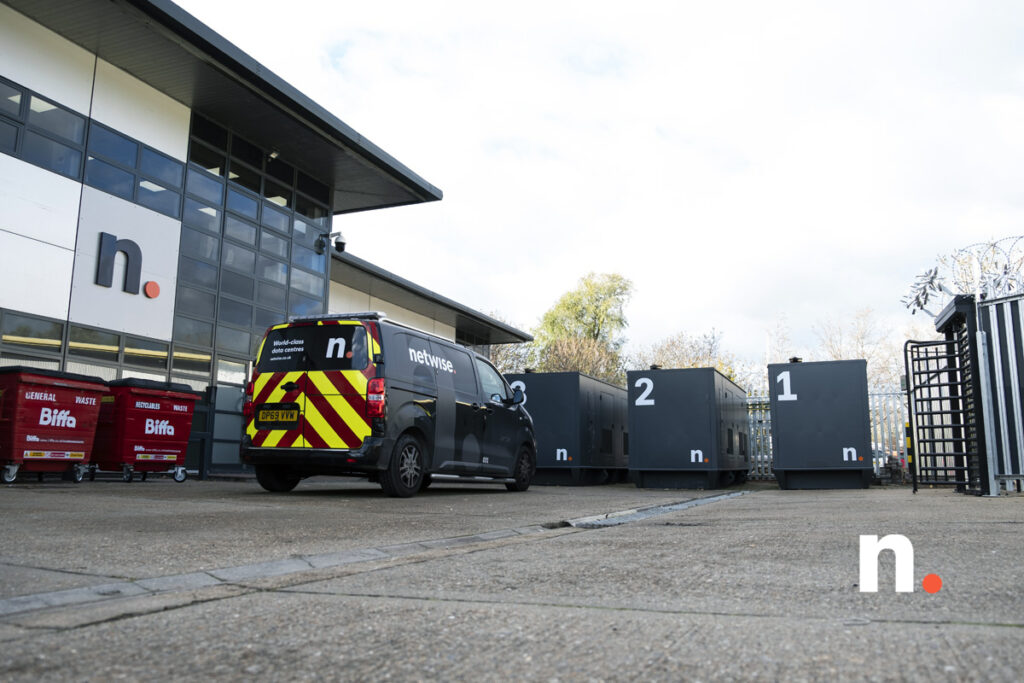Another 12 months in the books, and another record-breaking period for Netwise, which we’re immensely proud to share with our clients and stakeholders as we look ahead to another equally exciting year.
As we step into 2024 for the first time this week, we’ll take a moment to look back and appreciate the year gone by; the first full year of live operation at Netwise London East.
The headline is that development works have continued at pace at our London East facility, as we prepare to bring Data Halls 3 and 4 online in early 2024, enabling our next phase of growth and expansion.

At the point of closing out 2023, we’ve pushed development works into all corners of our London East facility, with upstairs now fully deployed (Data Halls 1 and 2), and downstairs deployment underway (Data Halls 3 and 4). The site has been a hive of activity over the past year, and we have plenty to show for it.
Notable projects from 2023 include:
- We fully deployed Data Hall 2 – the second active Data Hall within NLE welcomed its single long-term tenant in 2023; a major milestone for both parties. We enjoyed watching the space fill out with a wide range of cutting-edge hardware in Q4 2023.
- Phase 2 works have ramped up – while we technically included the build of Data Hall 2 in the Phase 2 works schedule, the real meat of this phase comes in the form of Data Halls 3 and 4. These two new halls are being readied for occupation in early 2024, with the closing stages of 2023 seeing real traction in this area; Data Hall 4 now has its primary cooling system deployed, as well as much of the core electrical distribution infrastructure.
- Josh Carvalho joined as Engineering Manager – in September, we expanded our team with the joining of Josh, our new Engineering Manager. Expect a full introductory post very soon.
- NLC again exceeded its design PUE, reaching a remarkable 1.09 – back in 2022, London Central achieved a real-world PUE of just 1.11, beating the design PUE target of 1.12. In 2023, we managed an incredible 1.09. We’re extremely excited to see where we can get NLE as occupancy rates rise rapidly, looking towards the design target of just 1.05.
- We added a range of niceties and features to NLE – we rolled out a range of new features at our London East site, such as on-site EV charging, recycling and general waste points, Dyson hand dryers throughout the building, improvements to lighting, additional Naturewall cladding; all of which we hope will improve customer experiences inside the facility.
- Our next round of software development works began – in the closing stages of the year, we set in motion a wide range of software development works, including improvements to our customer portal (for power and bandwidth monitoring), an in-house IP management tool, and the roll-out of our own QR code check in system, the latter of which has been working well for us since its full roll-out in the summer.
The general focus over the past 12 months has been to expand into the current footprint at NLE more completely, moving from the initial deployment phase of a single hall, to making use of all four halls within the current building. We now have active works underway across every sector of the site.
London Central has also seen its fair share of input, largely in the form of ongoing maintenance operations, with activity across many critical systems. NLC is also now home to our significant stock of APC racks, which are being pre-staged there before heading to NLE for active service.
Beyond the exciting physical development works, we’ve posted exceptional financial growth metrics again in 2023, which will support our ongoing expansion aspirations, and of course contribute to continued rock-steady reliability for clients all around the world. Base revenues for the year grew by just over 30%, which for our fourteenth year of trading is something we’re extremely proud of.

We have some very exciting news to share about additional future expansion at London East very soon – enabling Phase 3 of development – taking us to new heights at our ever-evolving Canning Town address.














